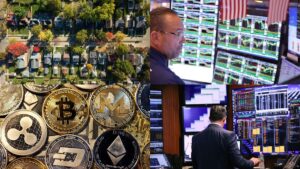The wonks call it climate Christmas – the dump of Australian climate change information from the federal government that happens shortly before the end of the parliamentary year, and just as the annual UN climate summit kicks off.
It’s impossible to get across it all in one brief sitting, so this is by necessity a first look only, but the hundreds of pages of data published in five documents on Thursday tell us a lot about where Australia is up to on the climate crisis, and where it is heading.
Perhaps the most striking is the annual progress report by the Climate Change Authority, the independent advisory body that has had its funding and role restored since Labor was elected.
It is blunt on the scale of the damage already being done to people and nature from human-caused global heating. “This is what 1.1C degrees of warming has looked like this year: news about wildfires in countries such as Hawaii, Spain, Greece and Canada; floods in China, India, Pakistan and Nigeria; and heatwaves in the UK, Europe and India,” the report says.
“July 2023 was the hottest month in over a century of global temperature records, and thousands of climate records have been exceeded worldwide. The risks of cascading effects and tipping points are mounting. Winter sea ice in Antarctica was at a record low in 2023 and ocean currents are slowing. Only strong and urgent action to reduce greenhouse gas can get us on a much safer climate trajectory.”
This summary, both shocking and familiar, bears repeating and absorbing. But the authority is equally blunt on the evidence of the straight-up economic risks to Australia if it fails to act, which remains less well understood.
It says time is running out for Australia to make the shift to being a “prosperous net zero economy on our own terms”. The message is: change is coming one way or the other. Australia can either quickly embrace the opportunities of a low emissions world, or suffer the consequences of having it forced upon it.
Those consequences are brutal economic disruption. It describes Australia as a “small, open and emissions-intensive economy, reliant on inflows of foreign capital and export income” that can “expect to feel the full force of the global transition to net zero emissions”.
Chris Bowen makes a similar case, albeit using different language. In his annual climate statement to parliament, the climate change minister argued the Albanese government was acting, but warned of challenges ahead.
He said a race for global capital was well under way, spurred by the extraordinary A$560bn clean energy incentives and tax credits included in the US Inflation Reduction Act, with the EU, Canada and Japan among those to have introduced measures in pursuit. He could have also mentioned China, which two reports this week found has been building wind and solar capacity at twice the rate of the US and Europe combined.
Bowen said while Australia had world-leading resources in solar, wind and critical minerals, that alone would not make it a renewable energy superpower. He summarised: “Having a clearly articulated plan for the transition is no longer optional, but a baseline expectation of capital markets.”
Does Australia have a clearly articulated plan? Bowen says yes. The climate Christmas report avalanche tells us there’s plenty of detail to come.
The immediate picture isn’t great. The new quarterly emissions data for June, covering Labor’s first full-year in office, shows pollution went up by 0.8%.
There are some ok-ish excuses for this. Transport emissions leapt by 8% as people emerged from Covid-19 restrictions. And agriculture emissions rose because it was wet. Crops and livestock were plentiful.
Labor can argue this rebound was basically locked in when it took power. But it is also true that the government is yet to release policies to stop pollution from transport and agriculture continuing to rise.
An emissions projections report, also released on Thursday, tells the story. It says current policies should get the country to a 42% cut in emissions by 2030 – nearly in line with the government’s 43% target – and a 53% cut by 2035 (compared with 2005). Those numbers are due to two things: solar and wind energy replacing old coal generators to clean up the power sector, and changes in land-use that are mostly unrelated to climate policy.
Bowen will deserve significant credit for the fall in electricity emissions, assuming it comes off. He last week announced a substantial expansion of taxpayer underwriting of renewable energy and storage, heeding calls that more was needed to drive private investment.
But other parts of the economy – transport, major industry, mining and farming – are still projected to emit roughly the same amount of CO2 in 2030 as in 2005. Like Australia’s vast fossil fuel exports, which are mostly not captured in domestic emissions numbers but contribute much more to the global problem, that isn’t sustainable.
Bowen rejected some steps on Thursday that the Climate Change Authority believed could have helped. They included coordinating a national phase out of household gas connections and setting a goal of zero emissions from cars by 2040, which would effectively mean replacing the national fleet in 17 years.
Both would have been politically and logistically challenging. The Coalition is in full-bore opportunistic mode on the climate crisis. Peter Dutton’s high-minded intervention on Thursday was to joke that Bowen would take a people smuggler’s boat to the Cop28 summit in Dubai to avoid emissions. But the country isn’t going to get where it needs to be without political daring, and changes in the way we live.
There is a moment coming that hasn’t had much attention, but could address some of these issues. The government is next year due to release sectoral decarbonisation plans for each of the areas in which emissions cuts are needed – energy, transport, industry, resources, agriculture and land, and buildings.
If done well, this should provide pieces currently missing from the Australian emissions reduction puzzle. It could set the stage for an ambitious 2035 target – one significantly higher than what emissions projections currently suggest – and a better chance of a future on something approaching our terms.
Coin Master Free Spins Today: Quick Tips
Earn Free Avacoins in Avakin Life Like a Pro
Free Credits in Bingo Blitz: Your Path to Bingo Success
TikTok Coin Generators: Fact vs. Fiction
Secretos para Recolectar Monedas Gratis en TikTok
LivU Video Chat Free Coins Hack: A Complete Overview
Elevate Your Coin Master Adventure: Free Spin Coin Master
The Art of Earning TikTok Coins
Sfrutta al Massimo i Regali in Monete TikTok
Elevate Your LivU Video Chat Adventure: Free Coins
Where to Find Free Spins in Coin Master: Your Guide
Unlimited Avacoins in Avakin Life: Myth or Reality?
Free TikTok Coins: Where to Find Them
Comment obtenir des pièces TikTok gratuites : Guide complet
LivU Video Chat Free Coin Generator Scams: What to Avoid
Unlocking Free Spins in Coin Master: Insider Techniques
TikTok Coin Generators: Fact or Fiction?
Steigern Sie Ihre TikTok-Follower mit Kostenlosen Münzen
How to Legally and Quickly Get Free Coins in LivU Video Chat
Insights from Pros: Coin Master Free Spins Farming Strategies
Earn Free Avacoins in Avakin Life Like a Pro
TikTok Coin Hack Myths Debunked
Iniciándote en las Monedas de TikTok: Guía para Principiantes
Insights from Pros: LivU Video Chat Free Coins Farming Strategies
Coin Master Free Spins Farming: Tips for Success



